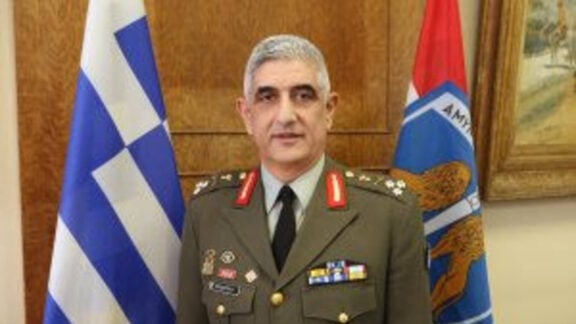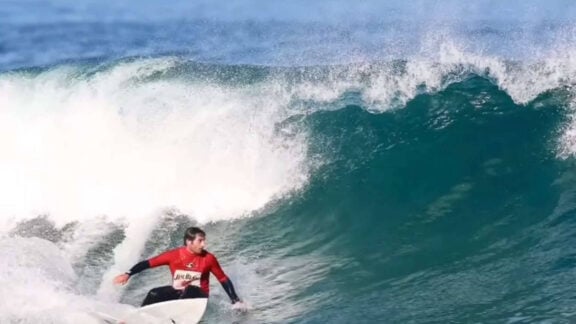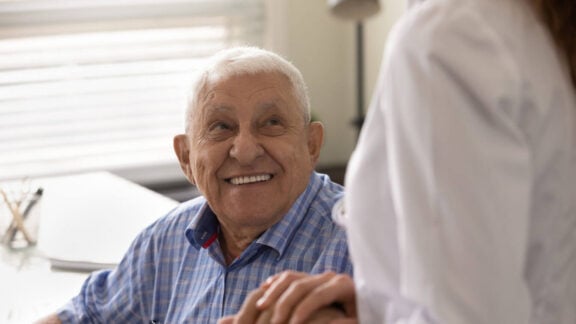Important and unique historical documentation supporting the role of Lemnos in Australia’s Gallipoli campaign was recently donated and accepted into the archival collection of Melbourne’s State Library of Victoria.
The donation took place in Camberwell, where the Library’s Dr Kevin Molloy reviewed and received the material from Elizabeth Connor, the daughter of Gallipoli veteran Lieutenant Roland “Ron” Newitt, Military Cross. The donation was witnessed by myself and Deb Stewart, herself the granddaughter of veteran Nurse Evelyn Hutt and a personal friend of Elizabeth. The collection will now be catalogued by the Library.
Ron Newitt was a 21 year old tram conductor from Tasmania who enlisted in August 1914, being appointed to the machine gun section of the 12th Battalion, a unit raised in Tasmania and one of the first battalions raised by Australia in the First World War. He would serve at Gallipoli and on the Western Front. Wounded at Gallipoli, Ron was treated in England before returning to Australia where he was sent to the new Royal Military College at Duntroon at Canberra to receive his officer training. He would be promoted – first to Second Lieutenant in 1916 and then Lieutenant in 1917. He was awarded the Military Cross for his “conspicuous gallantry and devotion to duty” during an action in April 1917 on the Western Front in which attacking enemy forces were repelled, an enemy trench and a machine gun captured, with many losses inflicted on the enemy. He survived the war and returned to Melbourne. In the Second World War, Ron re-enlisted and served out the war in Australia.

It had been my pleasure to be invited by Deb to meet Elizabeth a few months ago. Elizabeth was keen to discuss how she could preserve her father’s military archive so it could be preserved and appreciated by future generations. As an Arts graduate of the University of Melbourne and former CEO of the Victorian State Film Centre, Elizabeth is aware of the importance of preserving archives.
This gave me the opportunity to review Ron’s archive that has been carefully kept safe for over one hundred years. Going through the large box of materials revealed a treasure trove for the historian. All of the material in the collection is accompanied by biographical notes and comments created by Elizabeth as a guide to her father’s collection.
The collection includes many wartime-era photographs and postcards illustrating much of Ron’s experience. One of these is a large album with an embroidered cover which includes nearly 30 individual photographs. It also contains a brochure for the opening of the Launceston YMCA Soldiers Club from April 1916 and two typed poems one entitled “Returned” and another “The Real Anzacs”.

In 1915-16 Ron was in England recovering from injuries sustained in the field. He spent time at the 1st Australian Auxiliary military hospital at Harefield Park. His collection includes copies of ten editions of the in-hospital magazine entitled “The Boomerang” as well as two photographic collections by his friend Nurse Elaine Cumming. The latter include a volume of postcards of the hospital as well as her own photographic album of some 156 photographs, including what appears to be the Australian High Commissioner in London George Reid presenting an honour to a soldier, a photograph from Gallipoli, two photographs of nurses and soldiers or patients and one of the clearest single photographs of Ron.
The collection also includes images and a notebook from his time at the new Royal Military College Duntroon at Canberra in 1916, where he received his officer training during the war. His notebook has the notes taken by him during his training classes, with the images comprising 13 photographic postcards of these early days of Duntroon as well as photographs of his graduation class, with notations as to many of his comrades, dated May and June 1916.

The collection also includes his Gallipoli Medallion, issued by Australia and New Zealand to veterans or their surviving families in the 1960’s. Sadly this was not issued to those who served on Lemnos (and the other Aegean Islands on which military personnel served during the campaign or much of the surrounding sea. I have raised this oversight with the Australian authorities on behalf of Melbourne’s Lemnos Gallipoli Commemorative Committee.
The archive also includes 8 collections of postcards (in envelopes by location), correspondence between Ron and his wife written during WW2 (the letters from his wife describe her daily life and activities raising the family in Melbourne while Roland was on service in Tasmania), and various other documents and receipts.
Most significantly for those interested in the Hellenic link to Anzac is the collections material relating to Lemnos. In this the collection includes Ron’s private war diary. This was kept by him and apart from a few introductory writings, records events experienced by him for 1-2 January, 28 February, 1-13 March 1915. Most importantly this includes the days in early March were he was part of the first Australian contingent to land on Lemnos, with a number of unique notations.

Arriving at Lemnos’ Mudros Bay on 4th March, Ron wrote in this diary of the “several battleships” already at anchor and of the view of Lemnos from his ship – “a glorious sight greeted our gaze. There were several villages to be seen lying bathed in sunshine and green fields, windmills etc.”
He records his coming ashore for the first time the next day to take part in a route march, which he “enjoyed … to the full”. Following the march Ron writes of visiting a local village – writing that they were curious to know what a Greek village was like –aiming to buy some fresh eggs. Here he writes of meeting some of the locals, including “a Greek girl who could speak English splendidly” He was so engaged that he was castigated for being late back to his ship.
The next day, following more training ashore, he writes that while the troops enjoyed lunch on the side of a hill overlooking a village “all the people came to see us” and brought cheese and other goods to sell. The Battalion history writes that the locals did a “roaring trade” with the soldiers on such occasions.
Lemnos also reminded Ron of home. He wrote on the 9th March “this Island resembles Tassie in nearly every respect”. Importantly he went on to record what he heard of the size and religious affiliation of Lemnos’ population at the time, writing that “the Island has a population of 36,000 including 200 Turks. The chief town [Myrina] is with a population of 2,500”, confirming the overwhelmingly Hellenic composition of the population. Departing Lemnos on the afternoon of 24th April, headed for Gallipoli and the landings, this would be the end of Ron’s Lemnos experience.

The generosity of Elizabeth and the Newitt family in making this donation of this important private archive to the people of Victoria will be welcomed by historians and researchers. Through their donation this material will not only be preserved but also made available to the public. For historians, the value of such donations cannot be underestimated.
As someone who has been researching and writing about the Hellenic link to Anzac for many years, I am personally very glad that this donation has been made. It is yet more evidence of the role of Lemnos in the Gallipoli campaign, and its Australian connection. As I have mentioned (and written at greater length elsewhere in this paper), the Newitt collection contains unique references to the experience of Australian soldiers on Lemnos in 1915, especially as it concerns the interaction of these young Australians with the local population. A big thank you to Elizabeth.
Jim Claven is a historian, writer and author. He has assisted veterans’ families in their donation of important archival materials to the State Library of Victoria, including the Evelyn Hutt, Syd Grant, Alfred Huggins, Gil Easton and Henry Moran collections. Readers seeking assistance in donating similar archives to public archives can contact Jim via jimclaven@yahoo.com.au









